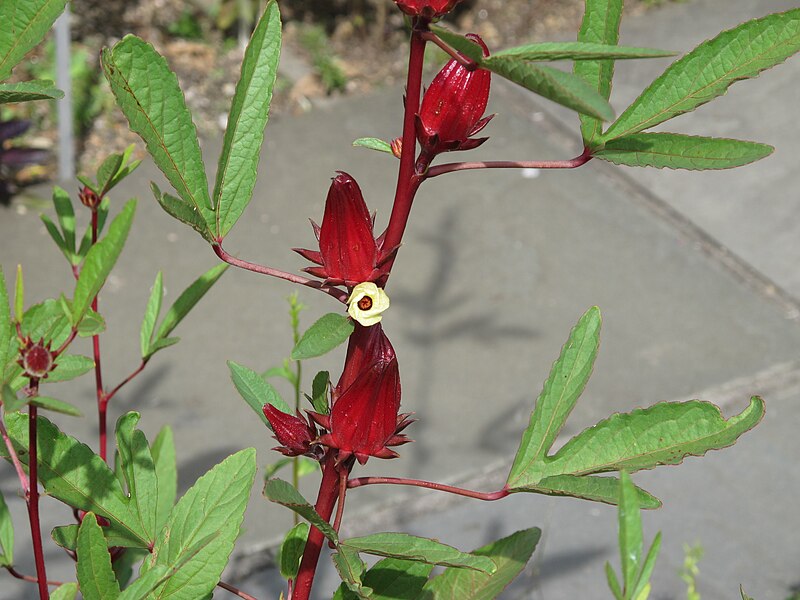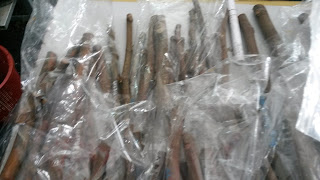Uses
The plant is primarily cultivated for the production of
bast fibre from the stem. The fibre may be used as a substitute for
jute in making
burlap.
[9] Hibiscus, specifically roselle, has been used in folk medicine as a diuretic and mild
laxative.
[10]
The red
calyces of the plant are increasingly exported to the United States and Europe, particularly
Germany, where they are used as
food colourings. It can be found in markets (as flowers or
syrup) in places, such as
France, where there are Senegalese immigrant communities.
[citation needed] The green
leaves are used like a spicy version of
spinach. They give flavour to the Senegalese fish and rice dish
thieboudienne.
Proper records are not kept, but the Senegalese government estimates
national production and consumption at 700 t (770 short tons) per year.
[citation needed] In
Burma their green leaves are the main ingredient in chin baung kyaw curry.
[citation needed]
Brazilians attribute stomachic, emollient, and resolutive properties to the bitter roots.
[11]
Vegetable
In
Andhra cuisine, roselle is called
gongura and is extensively used. The leaves are steamed with lentils and cooked with
dal. Another unique dish is prepared by mixing fried leaves with spices and made into a
gongura pacchadi, the most famous dish of Andhra cuisine that is often described as king of all Andhra foods.
[citation needed]
In
Burmese cuisine, called
chin baung ywet
(lit. sour leaf), the roselle is widely used and considered affordable.
It is perhaps the most widely eaten and popular vegetable in Burma.
[12]
The leaves are fried with garlic, dried or fresh prawns and green chili
or cooked with fish. A light soup made from roselle leaves and dried
prawn stock is also a popular dish.
Among the Bodo tribals of Bodoland, Assam (India) the leaves of
hibiscus sabdariffa and hibiscus cannabinus are cooked along with
chicken, fish, crab or pork, as one of their traditional cuisines.
[citation needed]
In the Philippines, the leaves and flowers are used to add sourness to chicken dish "Tinola" (chicken stew).
[citation needed]
In Vietnam, the young leaves, stems and fruits are used for cooking soups with fish or eel.
[13]
Beverage
- See also Hibiscus tea
In the Caribbean, sorrel drink is made from
sepals
of the roselle. In Mexico, 'agua de Flor de Jamaica' (water flavored
with roselle) frequently called "agua de Jamaica" is most often
homemade. It is prepared by boiling dried sepals and calyces of the
sorrel/flower of Jamaica plant in water for 8 to 10 minutes (or until
the water turns red), then adding sugar. It is often served chilled.
This is also done in
Saint Kitts and Nevis,
Guyana,
Antigua,
Barbados,
St. Lucia,
Dominica,
Grenada,
Jamaica and
Trinidad and Tobago
where it is called 'sorrel'. (In Jamaica, it was introduced by Akan
slaves in the late 1600s.) The drink is one of several inexpensive
beverages (aguas frescas) commonly consumed in Mexico and Central
America; they are typically made from fresh fruits, juices or extracts.
Something similar is done in Jamaica but flavor is added by brewing the
tea with ginger and adding rum, making a popular drink at Christmas
time. It is also very popular in Trinidad and Tobago where cinnamon,
cloves and bay leaves are preferred to ginger.
[citation needed]
In
Mali,
Senegal,
The Gambia,
Burkina Faso and
Benin
calyces are used to prepare cold, sweet drinks popular in social
events, often mixed with mint leaves, dissolved menthol candy, and/or
fruit flavors.
The Middle Eastern and Sudanese "Karkade" (كركديه) is a cold drink
made by soaking the dried Karkade calyces in cold water overnight in a
refrigerator with sugar and some lemon or lime juice added. It is then
consumed with or without ice cubes after the flowers have been strained.
[citation needed] In Lebanon, toasted pine nuts are sometimes added.
Roselle is used in Nigeria to make a refreshing drink known as Zobo.
[citation needed]
With the advent in the U.S. of interest in south-of-the-border
cuisine, the calyces are sold in bags usually labeled "Flor de Jamaica"
and have long been available in health food stores in the U.S. for
making
tea. In addition to being a popular homemade drink,
Jarritos,
a popular brand of Mexican soft drinks, makes a Flor de Jamaica
flavored carbonated beverage. Imported Jarritos can be readily found in
the U.S.
In the UK, the dried calyces and ready-made sorrel syrup are widely
and cheaply available in Caribbean and Asian grocers. The fresh calyces
are imported mainly during December and January to make Christmas and
New Year infusions, which are often made into cocktails with rum. They
are very perishable, rapidly developing fungal rot, and need to be used
soon after purchase — unlike the dried product, which has a long
shelf-life.
In
Africa, especially the
Sahel, roselle is commonly used to make a sugary
herbal tea that is sold on the street. The dried flowers can be found in every market. Roselle tea is quite common in
Italy where it spread during the first decades of the 20th century as a typical product of the Italian colonies. The
Carib Brewery Trinidad Limited, a
Trinidad and Tobago brewery, produces a '
Shandy Sorrel' in which the tea is combined with beer.
In Thailand, roselle is generally drunk as a cool drink,
[14] and it can be made into a wine.
Hibiscus flowers are commonly found in commercial herbal teas,
especially teas advertised as berry-flavoured, as they give a bright red
colouring to the drink.
Rosella flowers are sold as Wild Hibiscus flowers in syrup in
Australia as a gourmet product. Recipes include filling them with goats
cheese; serving them on baguette slices baked with brie; and placing one
plus a little syrup in a champagne flute before adding the champagne —
the bubbles cause the flower to open.
Jam and preserves
In
Nigeria, rosella jam has been made since colonial times and is still
sold regularly at community fetes and charity stalls. It is similar in
flavour to plum jam, although more acidic. It differs from other jams in
that the
pectin
is obtained from boiling the interior buds of the rosella flowers. It
is thus possible to make rosella jam with nothing but rosella buds and
sugar.
In Burma, the buds of the roselle are made into 'preserved fruits' or
jams. Depending on the method and the preference, the seeds are removed
or included. The jams, made from roselle buds and sugar, are red and
tangy.
"Sorrel jelly" is manufactured in Trinidad.
Rosella jam is made in
Queensland,
Australia as a home-made or speciality product sold at fetes and other community events.
[15]
Rujukan :https://en.wikipedia.org/wiki/Roselle_(plant)
Info tambahan:
OSELLE,
asam raya atau asam susur di kalangan orang tempatan merupakan tumbuhan
industri dalam keluarga Malvacee. Tumbuhan berbunga merah dengan nama
saintifik Hibiscus sabdariffa L.dipercayai berasal dari Afrika Barat tetapi ada yang mendakwa ia berasal dari India.
roselle
ditanam secara komersial oleh pekebun kecil di Terengganu atas tanah
bris dan berkembang di beberapa kawasan di Johor. Kaliks atau kelopak
dari bunga roselle boleh diproses untuk mengeluarkan jus minuman, jem dan jeli. Ia mengandungi kandungan vitamin C( asid askorbik ) yang tinggi iaitu sebanyak 260-280 miligram(mg) bagi setiap 100gram(g) kaliks kering. Selain itu,setiap 100g kaliks segar mengandungi 2.85 ug vitamin D, 0.04 mg vitamin B1, 0.06 vitamin B2 dan 0.05 mg vitamin B2 kompleks.
Sifat tanaman Roselle merupakan tanaman semusim dengan pokok bersaiz renik dan boleh tumbuh pada ketinggian 205 sentimeter ( sm ). Tempoh hayat ekonominya ialah enam hingga 10 bulan dan pada masa itu beberapa cabang akan keluar dari batang utama.Batangnya berwarna merah gelap dan biasanya pokok akan lodge semasa matang kecuali pangkasan dibuat. Daunnya berwarna hijau dan dan semasa peringkat awal, daun berbentuk bujur dan bertukar ke bentuk tiga jari. Pokok mula berbunga pada pada usia 45 hingga 60 hari selepas ditanam dan sekuntum bunga akan keluar pada setiap ketiak daun. Buah roselle berwarna merah gelap dan akan matang pada umur 35 hari selepas bunga kembang. Setiap buah akan mengandungi lima kaliks dan bercantum bersama di bahagian bawah bunga.Roselle hidup subur di tanah mineral dan tanah bris dan penanaman di tanah bris memerlukan pengairan dan pembajaan yang baik.
Roselle merupakan tanaman semusim dengan pokok bersaiz renik dan boleh tumbuh pada ketinggian 205 sentimeter ( sm ). Tempoh hayat ekonominya ialah enam hingga 10 bulan dan pada masa itu beberapa cabang akan keluar dari batang utama.Batangnya berwarna merah gelap dan biasanya pokok akan lodge semasa matang kecuali pangkasan dibuat. Daunnya berwarna hijau dan dan semasa peringkat awal, daun berbentuk bujur dan bertukar ke bentuk tiga jari. Pokok mula berbunga pada pada usia 45 hingga 60 hari selepas ditanam dan sekuntum bunga akan keluar pada setiap ketiak daun. Buah roselle berwarna merah gelap dan akan matang pada umur 35 hari selepas bunga kembang. Setiap buah akan mengandungi lima kaliks dan bercantum bersama di bahagian bawah bunga.Roselle hidup subur di tanah mineral dan tanah bris dan penanaman di tanah bris memerlukan pengairan dan pembajaan yang baik.
Penanaman
Penanaman
hanya menggunakan biji benih di mana biji disemai dalam bekas yang
sesuai dan anak benih sedia untuk ditanam ketika berumur 10-15 hari. Roselle
ditanam di atas batas berukuran 60 sm di tanah bris dan 90 sm di tanah
mineral.Ini akan memberikan kepadatan 7, 400 pokok sehektar pada tanah
mineral dan 11, 100 pokok sehektar pada tanah bris. Penanaman
roselle di tanah bris memerlukan penggunaan baja organik seperti tahi
ayam dan baja sebatian NPK 15:15:15 dan NPK 12:12:17:2.
Pengairan
Sistem
pengairan di peningkat ladang perlu dibina bagi menentukan paras air 60
sm dani permukaan. Bekalan air tambahan melalui sistem pengairan renjis
perlu dibina.
Kawalan penyakit dan perosak
Penyakit kulat biasa menyerang ialah reput daun (Coniella rnusaiaensis var.Hibisci) dan reput batang (Phoina spp).Kejadian ini mudah berlaku sewaktu musim hujan. Kawalan menggunakan racun kimia seperti Carbendazim pada 0.05 peratus adalah disyorkan. Serangga perosak yang biasa menyerang Roselle adalah bena hijau, kumbang dan kutu (Podogrica gemelle, Phylloreta spp.). Pengawalan
boleh dilakukan dengan menggunakan Deltamethrin, Fenvalerate atau
Carbaryl. Buah Roselle cukup matang dan sedia untuk dipungut pada 20 hingga 30 hari selepas bunga kembang.
Post harvest/pungut hasil
Pungutan buah roselle patut dilakukan pada selang tujuh hingga 10 hari untuk tempoh 50 hingga
60 hari. Pungutan dilakukan secara manual dengan memotong buah
menggunakan gunting. Buah roselle perlu diproses dalam tempoh dua hari
di mana buah dibuang kapsul untuk mendapatkan kaliks.
Khasiat dan kegunaan roselleKaliks
atau kelopak buah rosel yang berwarna merah kaya dengan vitamin A dan C
serta zat mineral.
- Dengan menjadikannya sebagai teh ubatan, herba ini
dapat membantu mempercepatkan peredaran darah, mengurangkan tekanan
darah tinggi di samping memberi kesan awet muda.
Kaliksnya boleh
diproses menjadi jem, halwa, jeli, jeruk dan juga pewarna makanan.
Pemprosesan biji rosel boleh dijadikan bahan kosmetik sementara kulitnya
pula boleh dibuat tali.
 Punya ladang rosel sendiri
Punya ladang rosel sendiri















































































































